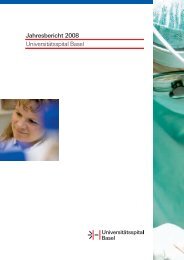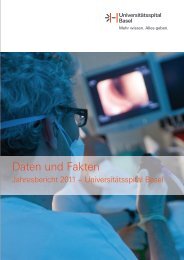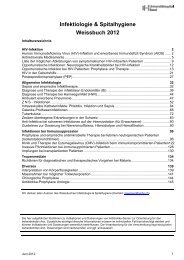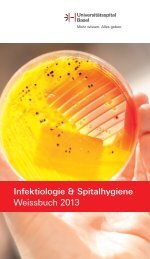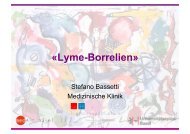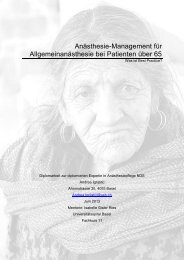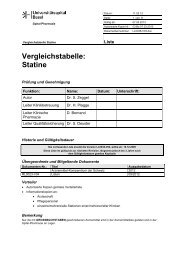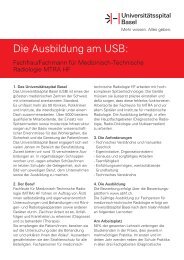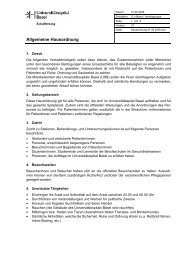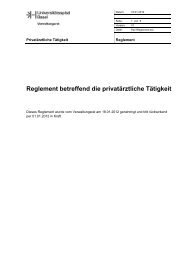Transmucosal Nasal Drug Delivery: Systemic Bioavailability of ...
Transmucosal Nasal Drug Delivery: Systemic Bioavailability of ...
Transmucosal Nasal Drug Delivery: Systemic Bioavailability of ...
Create successful ePaper yourself
Turn your PDF publications into a flip-book with our unique Google optimized e-Paper software.
8 Overall discussion<br />
unusual application experience may have influenced the subjective assessment <strong>of</strong> therapeutic<br />
effect.<br />
As the impact <strong>of</strong> cyclodextrin derivatives on drug release and absorption kinetics (in vivo) is<br />
controversially discussed in literature, midazolam was nasally delivered without RMβCD<br />
(Preparation 1) and with equimolar RMβCD (Preparation 2). In aqueous solutions maximal 5 mg/ml<br />
midazolam (base) can be solubilized by dissolving midazolam hydrochloride. Therefore, the impact<br />
<strong>of</strong> RMβCD on pharmacokinetics <strong>of</strong> nasally applied midazolam was studied at the concentration <strong>of</strong><br />
5 mg/ml midazolam base (Preparation 1 and Preparation 2). This midazolam concentration is equal<br />
to Dormicum ® 5 mg/ml and only adequate for transmucosal delivery <strong>of</strong> low-dose midazolam.<br />
RMβCD, added in equimolar amounts to midazolam, demonstrated neither penetration enhancing<br />
nor penetration inhibiting effects on transmucosal nasal delivered midazolam. RMβCD proved to be<br />
an adequate solubilizer in preparations for transmucosal nasal midazolam delivery.<br />
Bioequivalence was confirmed for all tested nasal administration modalities for nasal delivery <strong>of</strong><br />
1 mg midazolam (Project II). According to Fick’s first law, absorption <strong>of</strong> 1 mg nasal delivered<br />
midazolam following nasal administration <strong>of</strong> half concentration (5 mg/ml) on doubled application<br />
area (two-sided administration) was equivalent with one-sided administration <strong>of</strong> doubled midazolam<br />
concentration (10 mg/ml, Preparation 3). Hence, transmucosal nasal midazolam absorption<br />
demonstrated direct proportionality to (total) midazolam concentration and to the application area.<br />
Unlike in vivo midazolam absorption (Project II), in vitro midazolam release was reduced by<br />
equimolar RMβCD (Project I): doubled midazolam concentration (solubilized with equimolar<br />
amount <strong>of</strong> RMβCD) did not result in doubled midazolam release from the donor compartment into<br />
the receptor compartment (in vitro). Apparently, not the total midazolam but the free midazolam<br />
concentration determined midazolam release in vitro.<br />
In the nasal cavities (in vivo) there are a lot <strong>of</strong> molecules (components <strong>of</strong> the mucus layer or <strong>of</strong> the<br />
cell surfaces) potentially interfering with the cyclodextrin-drug complexes. Therefore, midazolam<br />
release in vivo is probably facilitated by competitive displacement <strong>of</strong> complexed midazolam<br />
molecules [Stella, et al. 1999].<br />
The in vitro drug release studies showed different midazolam release for midazolam preparations<br />
with RMβCD (equimolar) and without RMβCD. However, overall transmucosal nasal midazolam<br />
uptake, resulting <strong>of</strong> midazolam release, penetration, and permeation processes, did not reflect the<br />
differences <strong>of</strong> midazolam release observed in vitro (Project I). Apparently, in vitro drug release<br />
studies revealed differences in midazolam release, that in vivo were <strong>of</strong> inferior importance. Thus,<br />
drug release studies were not reliable models to predict absorption kinetics <strong>of</strong> nasally applied<br />
midazolam preparations.<br />
Osmolality <strong>of</strong> all proposed preparations for transmucosal nasal midazolam delivery was adjusted to<br />
physiologic conditions. For preparation proposed by Roel<strong>of</strong>se et al., containing 20% <strong>of</strong> βCD to<br />
solubilize 10 mg/ml midazolam, pH was 5.8. But as this preparation showed reduced systemic<br />
midazolam bioavailability following nasal administration, adding <strong>of</strong> excess cyclodextrin was<br />
Katja Suter-Zimmermann Page 99 <strong>of</strong> 188 University <strong>of</strong> Basel, 2008




